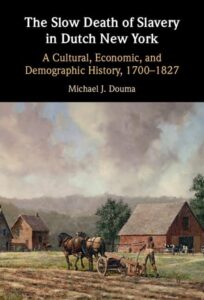The Slow Death of Slavery in Dutch New York , Michael J. Douma (New York: Cambridge University Press, 2024)
Reviewed by Firth H. Fabend
 Michael J. Douma’s book The Slow Death of Slavery in Dutch New York will be published in October by Cambridge University Press, and we are thrilled to be able to give an advance peek of it to our readers. Besides being Associate Professor at the McDonough School of Business at Georgetown University, Michael Douma is director of the Georgetown Institute for the Study of Markets and Ethics. These qualifications, plus the book’s subtitle, A Cultural, Economic, and Demographic History, will alert readers to an analysis of the subject such as has not appeared heretofore. This review of it is in the New Amsterdam History Center Newsletter, and that is fitting, because the book contains much that is new—and thus news.
Michael J. Douma’s book The Slow Death of Slavery in Dutch New York will be published in October by Cambridge University Press, and we are thrilled to be able to give an advance peek of it to our readers. Besides being Associate Professor at the McDonough School of Business at Georgetown University, Michael Douma is director of the Georgetown Institute for the Study of Markets and Ethics. These qualifications, plus the book’s subtitle, A Cultural, Economic, and Demographic History, will alert readers to an analysis of the subject such as has not appeared heretofore. This review of it is in the New Amsterdam History Center Newsletter, and that is fitting, because the book contains much that is new—and thus news.
The book argues that to understand the history of slavery in Dutch New York, that history needs to be recognized “as more Dutch, more profitable, more rural, and more enduring” than has been thought and taught. Historians of the Dutch in America up to the early nineteenth century especially will want to become familiar with Douma’s thinking.
In his Introduction, on page 12, the author lists eight assumptions that he seeks to overturn. The most important are that slavery in New York was primarily an urban phenomenon, that it was generally unprofitable, that its growth was driven mostly by importation, not domestic factors, that Dutch New Yorkers discouraged slave women from having children, that control over slaves increased over time, and that tens of thousands of New York slaves were sold South as New York prepared for the date of slave emancipation in 1827. In overturning these widespread assumptions, Douma thoroughly though gently and without snark challenges impressions held and furthered by both well-known historians and the public in general. Historians of the Reformed Church in America should be particularly interested in his views on E. T. Corwin, as I am.
The topic of the rural Dutch slave in New York in relation to wheat receives deep treatment in Chapter 2. The cultivation of wheat was so common and so traditional in New York, Douma writes, that Dutch farming (and thus slavery) was synonymous with it. But why, when the slave cost the farmer his upkeep all year long, did the New York Dutch farmer rely on slaves instead of hiring temporary hands as needed? The answer is complex. Slaves provided a labor source to expand production and thus increase the farmer’s profits. With extra hands, fallow land could be planted; moreover, since the wheat harvest was brief, about two weeks, hired men were not always available, or were expensive. Also, the slave could be required to take on all the myriad daily tasks of running a farm and the accompanying household. In short, on the relationship of labor and land, Douma makes the important point that when labor is scarce and land is plentiful, owning people yields a higher return to the landowner. Wheat functioned as a currency, he notes, and one more dependable than furs or wampum.
In Chapter 3, a detailed discussion of the price of slaves in New York and New Jersey, from 1700 up to around 1820, Douma analyzes the rise and fall of prices using cliometrics and regression analysis and enough tables and charts to warm the cockles of any economist’s heart. However, his statement on page 88 that “The New York Dutch viewed slaveholding as natural and justified it biblically” is one I question. Many church-going Dutch in New York and New Jersey were deeply disturbed by the contradictions that slavery presented to their religious beliefs.
But this is a quibble in relation to his main subject. Throughout this book, readers will find amazing insights based on Douma’s deep understanding of the numbers and the facts. For instance, the enslaved were agents of their emancipation, rather than the object of abolitionist action, there were about 76,000 slaves in New York State in the eighteenth century of whom 30 to 40 percent spoke Dutch (thus they were not an “occasional curiosity, but a commonplace”,) p. 21, and there is a subtle difference between the terms enslaver and slaverholder (p. 18). Among many revealing discussions, Douma’s chapter on the so-called mild-slavery thesis lays out how the mild thesis came about, why arguments about it are “more complicated than recognized,” and why its influence has been so powerful and persuasive in the historiography (p. 21).
All in all, a most satisfying book. The Slow Death of Dutch Slavery in New York will definitely cause waves in historical circles, but waves that will ultimately be admired for their exhilarating freshness.





